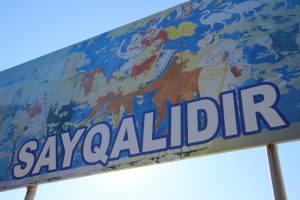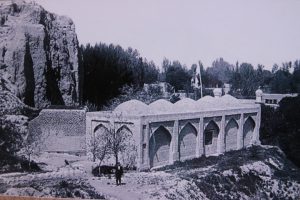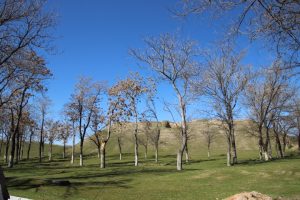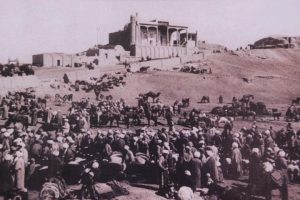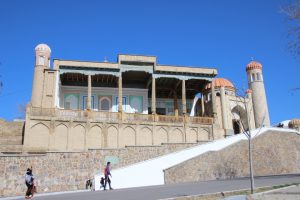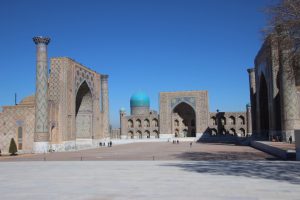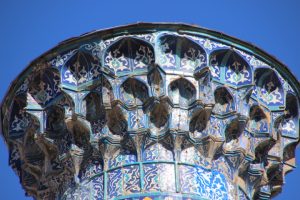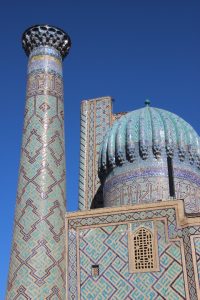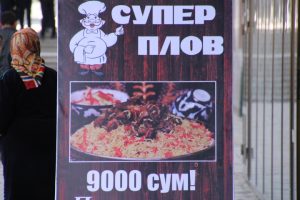We awoke to a beautiful sunny morning heralded by birdsong.
Samarkand is one of the most ancient cities of the world and a rare one as it has been fought over by three of histories greatest generals; Alexander the Great, Ghenkis Khan and Timur. The ancient part of Samarkand is situated on a hilly area named after a Turanian king, Afrasiab. A settlement was built here in the early 7th century BC. Some remains have been found including wall paintings from the royal palace dating to the 8th century BC.
The archaeological excavations here seem to be more or less abandoned but we think we found the site of Marakanda (early Samarkand). We also attempted to find the tomb of the Old Testament prophet Daniel. It is thought to be a low structure topped with domes and contains a sarcophagus which has to be enlarged as legend has it that Daniel’s body grows a little each year. His remains, which date to about the 5th century BC, were brought from Iran by Timur for good luck. The Iranians claim they still have him.
This is the mausoleum of Daniel that we were trying to find as shown on a photograph from the beginning of the 20th century.
The Hazrat-Khizr Mosque is at the entrance to the hill that forms the Afrosiab Park. Khizr is believed to be a protector of wayfarers and a possessor of ‘live’ water. This photograph was taken in 1890 and is rather unnerving as the people are actually standing on the course of today’s high speed duel carriageway!! There is little chance to stop a motor vehicle here and no bridge has been provided, so crossing the road today is an experience!!
In a guide book the mosque is described as being at a crossroads on the Old Tashkent Road. This has been obliterated by a concrete lined cutting, but in doing so has actually elevated the position of what some describe as Samarkand’s most beautiful mosque ‘with its fine domed interior and ribbed ceilings dripping colour’. All of which was out of bounds for us today.
To reach here we walked past the Registan
and along the now pedestrianised Old Tashkent Road. This pleasant urban walk took us past the Bibi-Khanym Mosque, also called the Amir Timur Mosque which was constructed as the main mosque of Samarkand in the early 15th century. The best architects, artists and craftsmen from a variety of countries were involved in its construction for 5 years. Indian elephants were even used for heavy lifting. It is thought Timur returned from a campaign and was disappointed by the scale of the construction, so it was made 45metres high with big pylons and minarets and arches up to 60m in height. Unfortunately the mosque was so big that the brick design behind all the colourful facades could not bear the weight and so the mosque collapsed little by little. By the time of reconstruction the building was in ruins and was not restored until the early 21st century. It is still undergoing restoration.
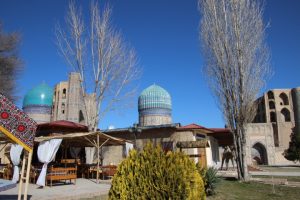
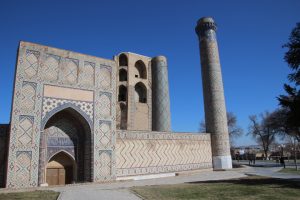
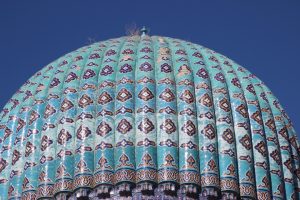
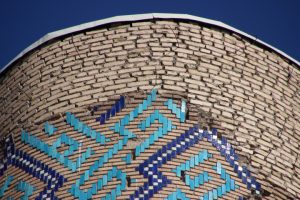
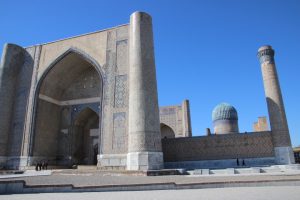
We rounded off the exploration with a meal, not of plov today, but of Lulya kebab (pieces of lamb, sweet fat and herb kebab), shashlik (keema kebab), sweet raw onion, home made bread and local beer. Delicious!
This is what it could have been like on the train! It says ‘Super Plov’.


